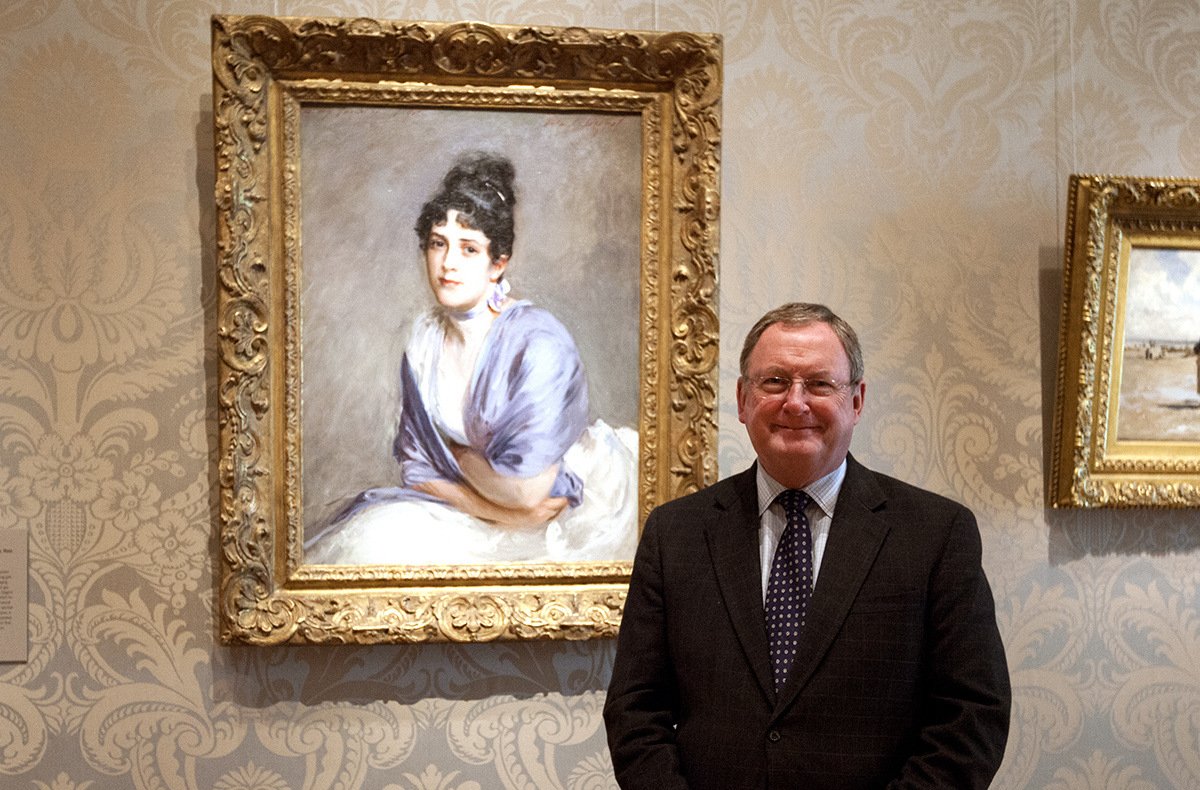Malcolm Rogers Presents 20 People Who Influenced Him in 20 Years at the MFA

Rogers took us on a tour of his favorite artworks at the MFA earlier this year. Here he is with ‘Mrs. Frank Millet’ by John Singer Sargent. / Photo by Olga Khvan
For 20 years, esteemed MFA director Malcolm Rogers has overseen hundreds of exhibitions, tens of thousands of acquisitions, and plenty of renovations big and small. He’s been a most influential figure in Boston’s arts and culture scene, and since announcing his retirement, the retrospectives on Malcolm Rogers’s time in Boston keep on rolling out.
Wednesday night, however, the Ann and Graham Gund director of the Museum of Fine Arts shifted the attention to others. In a talk titled “20 People for 20 Years,” Rogers presented a list of folks who have influenced him during his tenure at the MFA.
Here’s Rogers’s list, which ranged from notable world leaders, to his favorite artists, to you—the museum’s beloved patrons:
1. The Politician
Before joining the MFA, Rogers worked his way up in the ranks at the National Portrait Gallery in London, England. He said former Prime Minister Margaret Thatcher “saw things differently.” She viewed government funding for the arts as an investment rather than a duty, and also encourages museum leaders to go after private funding, giving institutions “greater freedom, but also greater responsibility.”
2. The Founder
Naturally, “The Founder” who influenced Rogers most was MFA originator Charles Callahan Perkins, also the founder of MassArt. “For him, education was key,” Rogers said, quoting Perkins mission to “win the high ground in the esteem of the community.” That mission statement of serving the community of Boston guided Rogers’s decisions at the MFA for years to come.
3. The Donor
“The spirit of philanthropy is ingrained in American culture,” Rogers said. Two philanthropists he called out as standout supporters in history were Marie Antoinette Hunt Evans, who contributed nearly 2,000 works early on, and Harriet Bradbury, who helped the MFA make it through the Great Depression.
4. The Collector
Of the many gifts given to the MFA over the years, these are the four collectors who stood out for Rogers:
• William Sturgis Bigelow, a physician who lived in Japan, gave the museum tens of thousands of Japanese art pieces.
• Denman Waldo Ross contributed 12,000 works, including three Monets.
• Saundra Lane doubled the museum’s photography collection by gifting a whopping 7,000 photographs.
• And Robert Owen Lehman contributed numerous historic bronze sculptures to the museum.
5. The Curator
The curators Rogers worked with in the last 20 years embraced the concept of teamwork to benefit “one museum, one world,” he said, calling them “heroes in the community.”
6. The Conservator
Preservation and conservation have not always kept pace, at the MFA, Rogers said, describing one sub-par storage space. He cited one example when a pair of delicate-looking 18th century red amber cruets were “found in pieces in shoeboxes in that hellhole.” Along with the new Art of Americas wing, some 80,000 pieces were moved into new state-of-the-art storage facilities.
7. The Colleague
Again, Rogers emphasized the importance of teamwork at the MFA, giving a shoutout to the museum’s management, finance, marketing, and other departments. He also showed an upbeat video about “The New MFA” featuring a reworking of the song “YMCA”—lyrics included, “We have everything, we have lots of free days, we have thousands of things to see!” Unfortunately that video is not available for public consumption, but trust me—it was cute.
8. The Volunteer
And Rogers would have been remiss to not point out that many of the friendly faces visitors encounter around the museum are volunteers, whether they are trustees sharing their work, wealth, and wisdom; senior staffers who acts as tour guides and ushers—you can thank them for the flower arrangements around the museum; and let’s not forget—interns.
9. The Educator
What’s the point of a cultural institution like the MFA if no one’s going to learn anything? Rogers sang the praises of the museum’s gallery instructors and pointed out several of the MFA’s educational programs and partnerships.
10. The Member
“We love our members and appreciate their role in sustaining the museum,” Rogers said, also pointing out that revenue rose from $3.6 million to $8.5 million in his 20 years at the MFA.
11. The Architect
A museum requires more than four walls and a roof. Rogers discussed Guy Lowell’s master plan for the MFA in 1907, I.M. Pei’s design of the West Wing and Linde Family Wing, and focused most on Norman Foster’s design of the Art of Americas wing, which “creates a miraculous balance between the old and the new.” Rogers said the idea was to make each gallery different, like a theater, and also noted that the decision to reinstate multiple entrances to the MFA furthered the original mission statement for the MFA to be a part of the local community.
12. The Artist
So—who are Malcolm Rogers’s favorite artists? If there’s any question to ask the director of a museum, this would probably be it, right? He shared Wednesday that it’s John Singer Sargent, “someone who also crossed the Atlantic a lot.”
13. The Other Artists
“Number 13 is a complete cheat, I’m afraid,” Rogers said, adding several more works to his list of favorites pieces at the MFA, including “Dragon and Clouds,” “Parakeets and Gold Fish Bowl,” and more.
14. The Gamechanger
By showing what some considered a controversial exhibition of work by renowned photographer Herb Ritts, whose subjects ranged from top fashion models to Nelson Mandela, the museum “broke the MFA’s brand as the stately dowager of Huntington Avenue.”
15. The International Partner
In the ’90s, Rogers and Kishiro Ito forged a partnership that launched the Nagoya/Boston Museum of Fine Arts in Nagoya, Japan. Again, Rogers referred to the original mission of the MFA, saying the sister museum continues “encouraging direct encounters with art.”
16. The Minister of Culture
In 2006, the MFA returned to Rome 13 antiquities that were thought to have been stolen from Italy. The act of goodwill connected the MFA with Minister of Culture Francesco Rutelli and began a collaborative effort between the MFA and Italy that has since brought us works by Michelangelo, Caravaggio, and in 2015, Da Vinci.
17. The Visionary
Surprise! Rogers’s “Visionary” isn’t a member of the art world, so much as a man who made the democratization of it possible. Tim Berners-Lee’s invention of the World Wide Web has created limitless possibilities for the MFA to share art with the rest of the world.
18. The Communicator
These days, when you want to know what’s happening at the MFA, you can go to MFA.org and find out. Rogers admitted he himself doesn’t understand everything about the Internet and social media, but he’s grateful for it anyway. You wouldn’t except a high art curator like Malcolm Rogers to be pro-selfie, but he is! He revealed that he actually encourages smartphones and selfies, which “unlike postcards, don’t turn yellow.”
19. and 20. The Visitor and the Visitors’ Representative
For numbers 19 and 20, Rogers spoke about the museum’s visitors and the “visitors’ representative”—himself for the last 20 years, and a role he’s passing on after his retirement. He closed his lecture by reiterating the areas that he feels are most important for the MFA to continue being successful, including global collaboration, teamwork, embracing new technology, and a balance between expert planning, but also the guts to experiment with new ideas.


